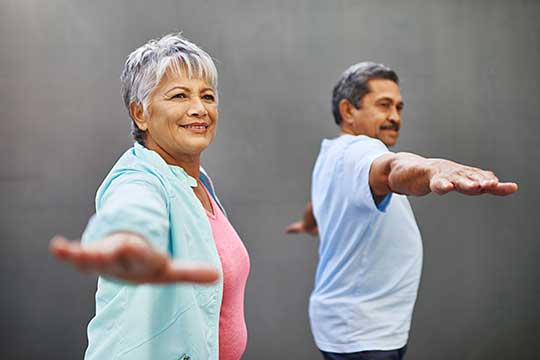How Can You Avoid the Risk of a Fall? Find Out How Balance Testing Can Help.

Yikes! Your risk of falling increases 140% for every 10 decibels of hearing loss, which means even mild hearing loss can triple your risk of falling.
Balance problems can be disorienting, unpleasant and can increase your risk of falling. Because the ear plays a pivotal role in your equilibrium, many balance disorders can be traced back to problems within the inner ear.
Balance testing helps determine how well your inner ears are functioning and communicating with the balance centers of your brain. If you’re experiencing vertigo or dizziness, for example, balance testing can help you identify the root cause and get you steady on your feet again.
What are the top types of balance testing?
Because there are several different causes of balance issues, we use a variety of diagnostic tools.
Videonystagmography (VNG) testing
If you suffer from nystagmus, or involuntary eye movements, this can make you feel dizzy and off balance. A videonystagmography is a test audiologists use to see if you have nystagmus and which part of the brain is causing this disorder.
During a VNG test, you will sit in a dark room and wear special goggles. The goggles have a camera that records eye movements. The first portion of the test is ocular testing, where you will watch and follow moving dots on a light bar. Next, we will do positional testing, where your provider will move your head and body in different positions to see if we can trigger the nystagmus.
The last part is caloric testing, where warm and cool water or air will be put in each ear. In a healthy vestibular system, the eyes move in certain ways depending on the type of stimulant we insert. If your eyes do not follow the norms, this could be an indication of vestibular system issues.
Electrocochleography (ECOG) testing
A special diagnostic called electrocochleography (or ECOG) is used to measure the amount of electrical potentials in the cochlea as it responds to sound. In this way, an ECOG diagnostic is similar to an ABR test. An ECOG test is used to differentiate between ear disorders.
This can help balance specialists better understand the source and the cause of your dizziness or vertigo. During an ECOG test, you will:
- Lie or sit in a reclined position.
- Have an electrode placed on your forehead and a foam electrode placed in your ear canal.
- Listen to the clicking sounds played during the test.
Some of the sounds may be loud, but an ECOG test should never be uncomfortable. There are no lingering effects from an ECOG test.
Vestibular Evoked Myogenic Potentials (VEMP) testing
In general, Vestibular Evoked Myogenic Potentials (or VEMP) testing is used to discover uncommon or unusual causes of your balance issues. This test is designed to monitor the signals sent between your inner ear and your brain. In particular, VEMP testing is looking at your vestibular nerve (located within your inner ear), which is responsible for sending balance-related messages to your brain.
During a VEMP test, you will:
- Sit in a reclined position with electrodes placed on your neck for cVEMPs and below your eyes for oVEMPs.
- Listen to knocking sounds.
- Lift your head slightly in various directions.
The whole procedure usually takes 30 minutes or less.
During the diagnostic, the VEMP testing will provide ear-specific information to help determine which side is disordered and causing the balance issues. In this way, VEMP testing can be useful in diagnosing Meniere’s Disease, Superior Semicircular Canal Dehiscence, and Perilymphatic fistula.
VEMP testing is completely non-invasive, and there are no lingering effects.
Discover what’s causing your vertigo
If you’re having trouble with your balance, or you’ve experienced dizzy spells and bouts of vertigo, it’s definitely worth having your balance tested. These diagnostics are safe and painless. Some may induce a feeling of dizziness or nausea.
To find out more about balance testing and see if you’d be a good fit for one of these tests, give us a call today. Most tests can be completed in less than an hour, so you can come in, get your diagnostic and discuss your results in short order.

